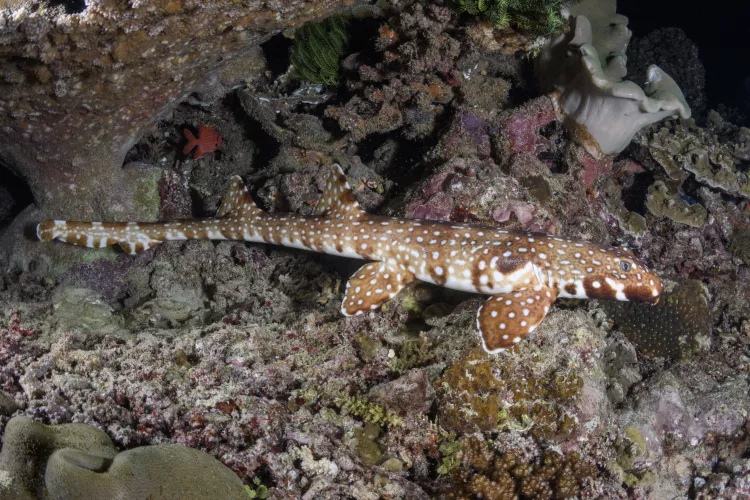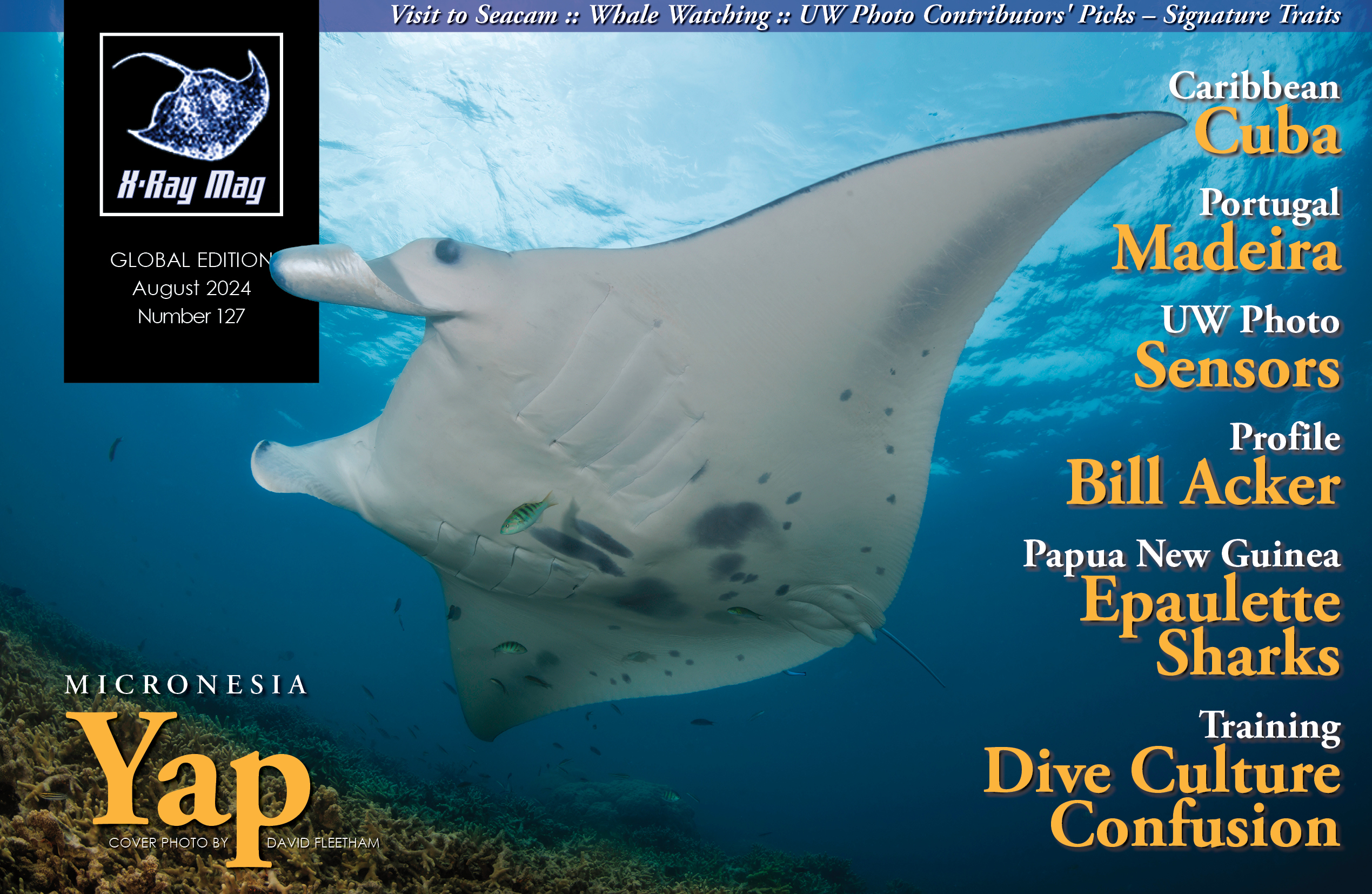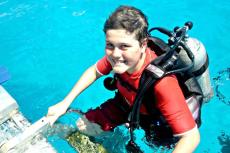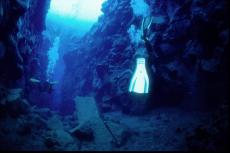Having photographed most of the sharks and rays that can be seen on scuba around the world, Andy Murch is doggedly pursuing the remaining few. Recently, his elasmobranch obsession took him to Papua New Guinea, where he hoped to find three endemic species of epaulette sharks.
Contributed by
Sometimes referred to as “walking sharks” because of the way they use their pectoral fins to clamber over the substrate, epaulette sharks are small, nocturnal predators that inhabit shallow inshore reefs within the Coral Triangle of Indonesia, northern Australia, and Papua New Guinea (PNG). Not far from world-renowned Raja Ampat, PNG is blessed with its fair share of coral-encrusted reefs, crowded with tropical fishes and exotic invertebrate life. The country’s best diving is concentrated around its offshore coral bommies, but PNG’s shallow inshore reefs are also worth exploring, especially if you are looking for epaulette sharks.
Sadly, rising sea temperatures have led to coral bleaching in some inshore areas. Combined with highly destructive dynamite fishing and toxic run-off from strip mining that poisons and clogs the reef, PNG’s coastal habitats have seen better days. Unsurprisingly, all three of the country’s endemic epaulette shark species are listed as “vulnerable” by the IUCN, so I was particularly keen to give them some time in the spotlight.
On to Tufi
After a gruelling 62-hour journey from Vancouver Island in British Columbia, Canada, to Tufi Resort on the remote eastern tip of PNG, I dropped my bags, threw my camera together, and stumbled down to the dive shop to enquire about a night dive. With dusk fast approaching, the dive shop manager immediately began rallying spotters to help me look for a leopard epaulette shark (Hemiscyllium michaeli), a species that is confined to a short stretch of coastline at this end of the country.

Diving
Slipping off the dock just after sunset, we levelled out at 6m and started scanning. Like most house reefs, Tufi’s check-out site was a bit scruffy, but the further we kicked from the dock, the healthier the corals appeared.
Under the cover of darkness, the night shift had already clocked in. Painted spiny lobsters waved their antennae wildly as if conducting invisible orchestras, and a variety of nocturnal crab species scurried about, nipping at anything potentially edible in their path.
The pre-show was fun to watch, but 45 minutes in, we still had not seen any walking sharks. During the kick back to the dock, I finally glimpsed the sinuous outline of a tiny shark, visible for a tantalisingly brief moment as it wriggled between two plate corals and disappeared into the inner sanctum of the reef. There was no way I could get a shot, but it was reassuring to see one firsthand.
The following night, we took a small skiff to the far side of the bay, where mangrove roots reach down to the shallowest corals, creating a shady haven for walking sharks and other light-averse creatures of the night. Sure enough, this turned out to be a far more productive spot. Within minutes of descending, one of the spotters frantically signalled me with his light, then pointed to an eel-like shape slowly making its way across a patch of hard corals. Carefully sinking down beside it, I was able to compose a short series of shots before it found a hole in the coral canopy and disappeared. Success!
The next one I stumbled upon took off like a mako, but the third was more relaxed, giving me time to enjoy its beautiful leopard-like markings. One species down, two to go.
On to Madang
With no time to linger, the next morning, I hopped on a flight back to the capital and caught another to Madang on the north coast of PNG. A decade ago, Madang was a highly regarded destination among adventurous, in-the-know divers. Sadly, the region has since developed a reputation for tribal unrest and violent crime. Numerous people on the flight cautioned me to be extra careful. One local even went so far as to tell me that I should be fine as long as I did not leave the airport compound!
A shrewder diver might have steered clear, but Madang is the only place where it is possible to see the hooded epaulette shark (Hemiscyllium strahani), so I was determined to give it a try. To make matters worse, the only dive shop in Madang had been closed since the pandemic. However, when I contacted the owners before I left for the trip, they were kind enough to arrange for a small cargo boat to take me to the outer reef and supply me with a couple of tanks.
At sunset, I carried my gear out of the hotel compound, trying to look as confident, inconspicuous and un-muggable as possible—not easy to do while wearing a neoprene suit and carrying a large underwater camera. Thankfully, it was only a short walk to the boat dock, where I was met by three local boatmen who directed me to their tiny banana boat.
On the way out to sea, we stopped at a small island to pick up a fourth crew member, which seemed like overkill, but they explained to me that they needed at least four guys sitting in the boat while I was underwater to avoid being attacked by machete-wielding pirates. As I absorbed this information, my eyes wandered to the now menacing-looking campfires I could see on the shoreline of the otherwise deserted islands we were passing.

Diving
After another 30 minutes, we arrived at a spot that the dive shop owners had said was a good place to look for walking sharks. Gearing up, I fell in and swam down alone to explore the terrain. Compared to Tufi, there were far fewer hard corals here, but the rocky substrate had an attractive purple hue and there was no shortage of fish life. It took less than a minute to spot my first hooded epaulette shark, a larger species with a reddish-brown torso peppered with bright white spots. Just as the paler leopard epaulettes from Tufi blend into their coral home, it made complete sense that this species would be darker and more plain in keeping with its rockier environment.
Fortunately, the hooded epaulette turned out to be far bolder than its eastern cousin, allowing me to compose some nice portraits before it nonchalantly wandered off. Before long, I ran into a second shark and then another and another. By the end of the dive, I had seen eight different hooded epaulettes, which was extremely encouraging considering their vulnerable status.
Surfacing after 60 minutes, I expected to find the boat hovering nearby, but there was total darkness and no sign of it anywhere. The current was pulling me steadily away from the island, so I threw on all my lights and started flashing in every direction to attract the crew’s attention if they were still in the area. At the same time, I was painfully aware that it might not be my boat that I was attracting, and other boats might not be so friendly, but a night adrift in the Bismarck Sea was equally unappealing.
Thankfully, after a few minutes, my boat emerged from the darkness, and I clumsily pulled myself aboard. I am still not sure whether they had no lights on the boat or whether they had turned them off to avoid attracting too much attention. Either way, reunited, we returned to shore unscathed, with a good story and a great selection of hooded epaulette shark images.
On to Loloata Island
Two days later, I was back in Port Moresby, riding in a private limousine to a luxury island resort south of the city. Located in the middle of Bootless Bay, Loloata Island Resort is the weekend playground of well-to-do expats residing in the capital. It is also a good spot to hunt for PNG’s other endemic walking shark species, the Papuan epaulette shark (Hemiscyllium hallstromi).

Diving
While the locals sat around the pool drinking cocktails, I set up a night dive at the resort’s small dive shop and got ready for the hunt. At dusk, a boatman dropped my dive guide and me off at the edge of the seagrass that surrounded the island retreat. The visibility was disappointingly poor—not surprising, considering we were diving in a shallow bay fed by numerous muddy rivers.
We spent a while exploring the fringing reef, which was struggling under a thick layer of silt. Although the river has been depositing sediment into the bay for centuries, farming and mining have increased the sediment load significantly, resulting in inevitable reef degradation.
We moved up into the shallow seagrass and continued the search. Apart from a few crabs, there was not much to focus on until a flash of orange darted out of the lush foliage. This epaulette shark was completely different from either of its cousins, sporting a lovely orange/tan torso with bold black polka dots. This gorgeous little shark was the friendliest yet, nonchalantly continuing its foraging through its miniature forest realm while I snapped away whenever I had a clear shot. I watched it hunt for a good 15 minutes before my dive guide dragged me away.
Tragedy
The next night would be my last chance to see epaulette sharks before flying out. Excited, I headed down to the dive shop at dusk, but when I arrived, the dive shop manager told me with tears in her eyes that the boat driver and skiff were missing—almost certainly taken by pirates. Apparently, the boat had disappeared while doing a routine run to the mainland earlier in the day. The resort had sent out a search party, but all they found was a drifting life jacket. When I asked what would have become of him, she said they would have either killed him immediately or simply thrown him into the water far from shore, which amounted to the same fate. She asked me if I would like to dive from shore, but photographing sharks felt too petty.
Shocked and horrified, I returned to my room and contemplated this tragedy that had utterly eclipsed the success of my trip. As I write this account, I still feel awkward about sharing this aspect of the story, but perhaps it illustrates why the fate of tiny sharks is not a high priority in a country where life itself hangs in the balance. ■






























